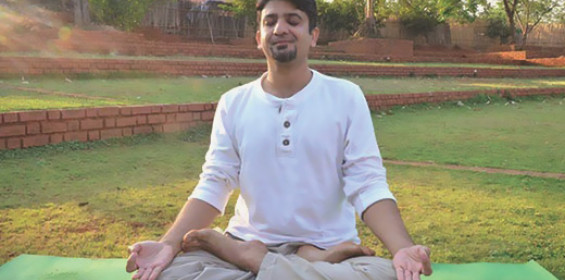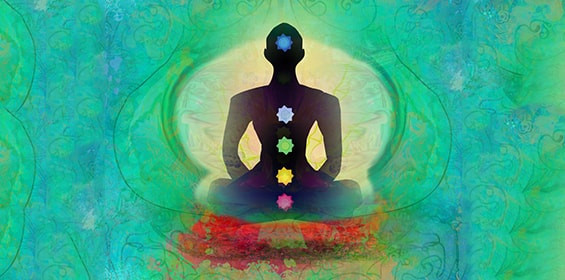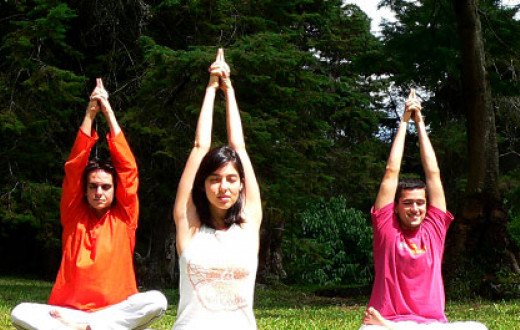By Financial Times┃Posted: February 14, 2019
Seated in the laboratory of India’s National Institute of Mental Health and Neurosciences in Bangalore, I’m wearing a tight rubber cap on my head. Near-infrared light transmitters and receivers are measuring the oxygen in my brain. And, for the sake of science, I’m chanting “Om” — the primal sound of creation, according to ancient Hindu scripture — as a computer monitor shows my brain’s activity levels.
The test is designed to show me how chanting — a key part of traditional Indian yoga — affects the forebrain, center of rational thought. The institute (known as NIMHANS ) has devoted years to research in this field, in an attempt to determine if yoga and meditative practices are demonstrably beneficial for mental health.
Despite a decade living in India, I have little yoga experience and I feel self-conscious as I take a deep breath and slowly release it in a prolonged “Om.” Straightaway, Dr Hemant Bhargav, a physician and yoga expert, corrects my intonation. “The OO should be chanted for five seconds and the MMMM should take 10 seconds,” he says. On the screen we can see my brain’s blood oxygen level — and thus activity — fall as I chant, then rise as I rest. Bhargav’s conclusion: my mind is more restful when I chant than when I’m silent.
Similar interpretations came from a NIMHANS study several years ago in which healthy volunteers alternated between chanting “Om” and hissing (as the control activity) inside an MRI machine. The researchers observed that the brain’s limbic region — the part of the mind that controls primal emotions and instinctive responses — was deactivated when subjects chanted “Om.”
Links between yoga and mental health
The efficacy of such practices is relevant in the context of India’s mental health burden and its acute shortage of mental health professionals. A NIMHANS -led survey estimated in 2016 that 150 million Indians — 10.7 percent of the population — suffer from a mental health condition. “Talk therapy” also sits uneasily in traditional Indian society.
“Most psychiatrists simply don’t have time to do anything else besides prescribe medicines,” says psychiatrist Dr. Shivarama Varambally, director of the NIMHANS yoga center, which started 10 years ago. “The treatment gap is very huge. But there are more than enough yoga therapists in India. If yoga can help fill this gap, it would be a great thing.”
Yoga was first described in the Yoga Sutras of Patanjali, an ancient Sanskrit text believed to date from about the 4th century. In 196 sutras, the sage Patanjali sets out a path to disciplining the human mind, in order to commune with the divine. His prescription is to shut out external stimuli and turn the mind inwards. The range of postures — or asanas — and breathing techniques — or pranayama — for which yoga is now known were devised later to help practitioners reach the exalted meditative state of samadhi described by Patanjali.
“Our consciousness most of the time moves outwards,” Bhargav says. “But moving the consciousness inward was given a lot of value in eastern philosophy. Fundamentally, according to yoga, [mental illness] is an imbalance of the inward and outward movement of the consciousness.”
One researcher’s findings
Dr BN Gangadhar, director of NIMHANS , began researching yoga’s impact on mental health patients in the mid-1990s, following an encounter with the spiritual guru Gurudev Sri Sri Ravi Shankar, his former schoolmate. The guru had developed a practice called Sudarshan Kriya, his own version of the pranayama of yoga. He urged Gangadhar to study whether it could help NIMHANS patients.
Gangadhar embarked on a study of Sudarshan Kriya’s effect on 45 people with mild but chronic depression. He also studied patients hospitalized for severe depression, some of whom started doing 40-minute sessions of Sudarshan Kriya three times a week, and some of whom received more standard medical interventions.
In both studies, he says, Sudarshan Kriya reduced levels of cortisol, a stress hormone that can trigger depression. “People with depression got better,” he says over tea at the sprawling NIMHANS campus, a collection of low-rise buildings tucked amid lush greenery. “Yoga practice was at least as good as medicines. It produced substantial benefits.”
Yet, Gangadhar admits that he couldn’t conclusively separate the psychological benefit of Sudarshan Kriya from the potential placebo effect — or rather “guru effect” — of its famous creator. “There is an element of suggestion effect,” he says. “Theoretically, it’s possible [that patients think] ‘since so-and-so is promoting it, I will get better.’”
The impact of yoga on patients
To test the premise further, Gangadhar studied the effects of more generic yoga. He and his research team developed “cocktails” of yoga asanas that were then tested on patients suffering from schizophrenia, depression, memory loss, ADHD, alcohol dependence, obsessive-compulsive disorder and unexplained pain.
Overall, he says, regular yoga practice led to clear improvements in patients’ conditions. It not only lowers cortisol but also raises levels of brain-derived neurotrophic factors — proteins vital for learning, long-term memory and repairing damage. He also says that yoga increases levels of oxytocin, the so-called “love hormone,” and improves social interaction.
Exercise can induce similar chemical changes in the brain. But a 2012 NIMHANS study of 120 schizophrenic patients found yoga’s impact on negative symptoms to be much stronger than other forms of exercise such as callisthenics practiced for the same amount of time.
What sets yoga apart is how practitioners are taught to concentrate on their bodies as they move into postures, hold them, and breathe. “All this is practiced by a person with full mindfulness,” says Gangadhar. “It’s not that they do the posture and are also listening to music headsets. They have to apply their mind.”
Yoga as a medical treatment
Yoga is now a regular part of treatment programs at the institute hospital. This year, for the first time, the yoga centre will also host a week-long course intended to introduce doctors, psychologists and social workers to its research.
But opinion is divided over the merits of yoga as a treatment. “There is a split in the medical profession,” Varambally says. “Some doctors are doing yoga and have started believing in it themselves, but there is a group opposed to the whole idea, saying this is watering down the medical profession.” Nonetheless, Varambally has received a grant from the UK’s Welcome Trust and the Indian government to understand the physical mechanisms through which yoga can help patients suffering from schizophrenia.
The NIMHANS researchers are not alone in their interests. Richard Davidson, Director of the University of Wisconsin’s Center for Healthy Minds, is studying Tibetan Buddhist monks to understand how long-term meditation affects the brain. Sat Bir Singh Khalsa, a professor at Harvard Medical School, has studied yoga’s impact on conditions such as insomnia, anxiety and stress.
Gangadhar sees these international efforts as critical to unlock the secrets of the mind. “We are like blind people touching the elephant,” he says. “Maybe one man will touch the ear; maybe someone will touch the tusk and somebody will touch the tail. We’re beginning to understand, but the brain is still a mystery.”
This article written by Amy Kazmin was originally published by the Financial Times (FT).


















































